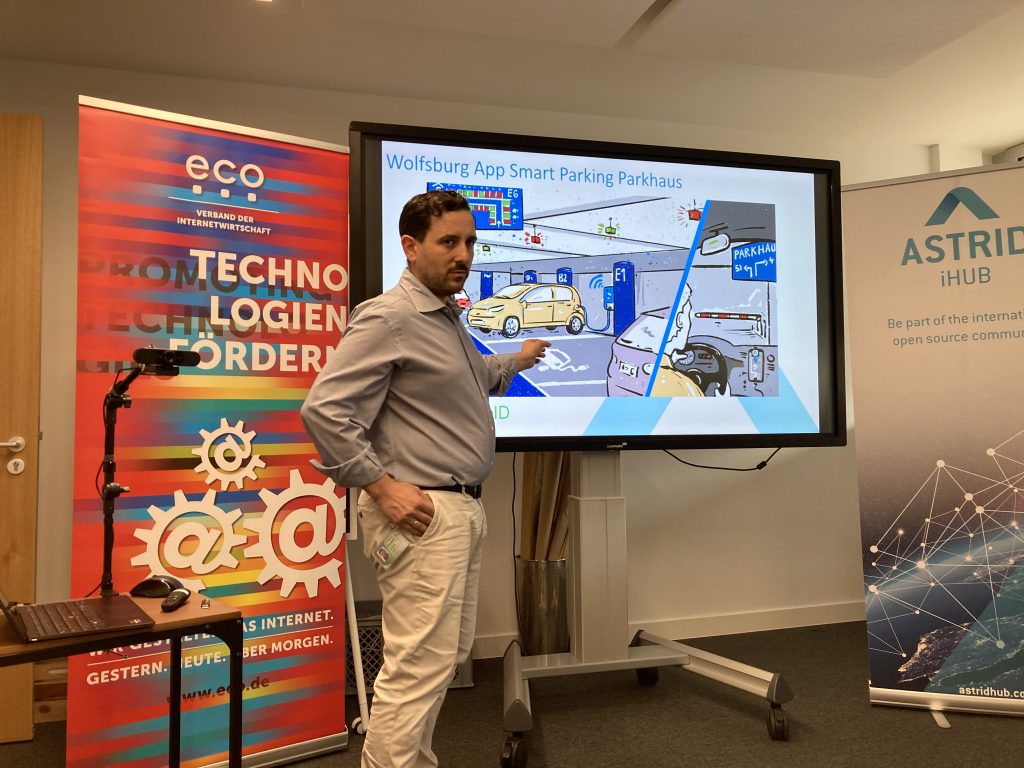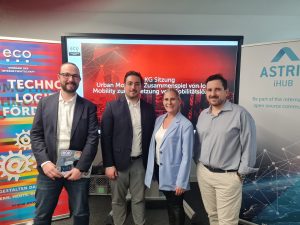At our Mobility Competence Group meeting,“Urban Mobility – Interaction of IoT and Mobility for the Implementation of Mobility Solutions”, eco entered into discussion with various experts from the mobility and IoT environment on the topics of data generation, data usage, data management and data policy. Together with our host, WOBCOM in Wolfsburg, and our CG Mobility Leader Giovanni Coppa, we arrived at exciting content and a highly productive CG meeting. A clear picture emerged of just how indispensable data usage is for mobility solutions in all areas. Various use cases were discussed, such as on smart parking, which plays an important role in the context of smart cities in order to minimise search for parking spaces in these cities. There were also exciting insights into the area of rescue mobility, not to mention the potential for data spaces and the shared use of (mobility) data.
Digitalisation for urban mobility
The baseline for a smart ecosystem is digital infrastructure which is well-designed and functioning – especially when it comes to urban mobility solutions. Building on this foundation, data can be generated and used for various apps. In the smart city context, it is also important that the citizens profit from the (mobility) solutions and derive a direct benefit from these. In Wolfsburg, this is precisely the approach that is being taken. With various solutions and concrete use cases, the city is showing how digitalisation potentials can be used for urban mobility concepts. With the Wolfsburg app, WOBCOM and various partners have created a platform that fits perfectly into the concept of a smart city ecosystem for the city.

Smart Parking
Using the example of smart parking and a signposting system, Wolfsburg demonstrates how the search for parking spaces within the city can be kept to a minimum with the help of appropriate digital infrastructure, IoT devices, the generation of data, its use and its consolidation. The concept and the solutions applied address both urban challenges and the needs of citizens in equal measure and can thereby also be adapted by other cities. The challenges include:
- Large number of vehicles
- Commuter traffic
- Connection to nearby cities
- Connection to rural areas
- Varying levels of parking occupancy
- Minimisation of the search for parking spaces
- Integration of e-mobility (charging facilities)
With the help of simple sensor technology and appropriate networking, as well as the use of the collected data, it has been possible to develop a smart parking guidance system that is available to citizens in the city app and that directly displays free parking spaces, including those with free charging stations.
Data spaces and data platforms facilitate mobility networking
In particular, Gaia-X projects such as the Mobility Data Space or moveID are gaining a growing level of attention in the context of networked and future mobility and are becoming increasingly important in enabling and establishing a long-term transparent, secure and decentralised data economy.

In the coming years, moveID is to develop the necessary standards and technological concepts that will enable the secure exchange of information between providers and customers of mobility applications. The goal is to achieve decentralised digital vehicle identities. This is a key requirement, especially for smart cities, automated driving and e-mobility. Smart parking and the Wolfsburg parking project are also part of moveID’s use cases, given that targeted access to parking facilities is an important contribution to reducing traffic and emissions; the search for parking spaces accounts for around a third of inner-city traffic.
Urban Mobility in the 5G Living Lab
The 5G Living Lab of DLR – Institute of Transportation Systems is dealing with a point of mobility that is not so often in the spotlight, but which is an imperative factor in connection with urban mobility solutions: namely, rescue mobility. Especially in the case of emergencies, what is absolutely crucial is to have a rapid arrival at the relevant location. While on the move, emergency planning with real-time images can cut back on minutes, save lives, or prevent worst-case scenarios. At the CG meeting, DLR presented two exciting use cases on this topic.
Rescue mobility
The use case of rescue mobility is clearly all about finding the best route after an incoming emergency call and arriving at the scene as quickly as possible. This can be implemented in a smart form, and the route can be coordinated with “green traffic-lights” so that the emergency services can move in an unhindered manner through urban traffic to reach the relevant location. Of course, it’s also important to communicate an emergency to the citizens in real time, with this requiring real-time networking, connectivity and data.
There are very clear advantages of 5G for rescue mobility:
- Lower latency
- Timely activation of the “green traffic lights”
- Automated driving functions
- Mobile Edge Cloud
- Decentralised data processing at the scene of the incident
- Broadcasting
- Efficient dissemination of information to road users
- Slicing
- Prioritisation of message packets
Rescue drone
Similar to the use case of rescue mobility, when it comes to a rescue drone, its aim is to enable the emergency services to act quickly and, above all, to carry out operations in a targeted and rapid manner. Here, with an incoming emergency call, a rescue drone that is closest to the scene of the incident is also sent out together with the emergency services. This gives these emergency services access to real-time images of the car incident and enables them to plan the operation in a targeted manner even before arrival. Here, too, 5G is a decisive factor in the implementation, and provides many advantages:
- Higher video resolution
- Zoom performance
- Sharper image
- Object detection performance
- Lower latency
- Drone control
- Camera control
- Improved “hand eye coordination”
- Broadcasting
- Prevent Peer to Peer: Lost Link | Beyond Visual Line of Sight
- All drones: same info | at the same time | from the same source
- Slicing
- Guaranteed “Quality of Service” for message packets
Data policy – where do we stand?
In order for data ecosystems and a fair data economy to function, framework conditions must also be created at the political level. There is also a need for conditions that meaningfully promote, advance and regulate the data economy.

Currently, much is happening in the area of data policy and work is being done to create an appropriate framework.
One of the ambitious goals at the political level is that 75% of companies in the EU should use big data or AI (artificial intelligence) by 2030, or at least have an understanding of the possibilities. The topic is also being taken up increasingly in Germany. Data is to be made more effectively available and more usable, and new projects are to be made possible for companies, academia and civil society. The following projects and laws are under consideration or are being planned:
- Research Data Act
- Data Institute
- Data Strategy
- Further development of the Mobility Data Space
- Promotion of Intermodal Mobility
- Mobility Data Act
At the European level, the aim is to create an internal data market with uniform standards, as already exists at the analogue level.
Data Act
The Data Act is likely to have an enormous impact on the data economy. It is a horizontal act that creates rules for all sectors and an overarching law that aims to regulate the handling of industrial rather than personal data. This is to be followed by sector-specific rules. A draft for the mobility sector is to be published this year. The background to the Data Act is to break down data silos at the regulatory level and thus promote the data economy in Europe. The Data Act initially covers all networked devices, which do not even have to be physically present.
Mobility Data Act
The Mobility Data Act is in the planning stage and is to be added to the existing regulatory ecosystem. Its aim is to once again provide very specific framework conditions and regulations specifically for the mobility sector. At present, however, very little is known about the act; the draft should be available by the end of 2023 and adopted the following year.
Conclusion
All in all, the use cases presented demonstrate how data has become indispensable for the mobility industry. Especially for new and holistic mobility concepts and mobility solutions, it is important to have access to the corresponding data and to use it collectively. Platforms and data spaces such as moveID and the Mobility Data Space are important pillars in the data economy and show how data sharing and data availability can work, and what opportunities for innovative mobility solutions and new business models can arise. At the regulatory level, there is currently a lot of activity around data topics. New framework conditions will certainly also raise new challenges for companies.
In our study “The Smart City Market in Germany: 2021-2026”, you can find more information on the topic of mobility in smart cities, such as searches for parking spaces.




